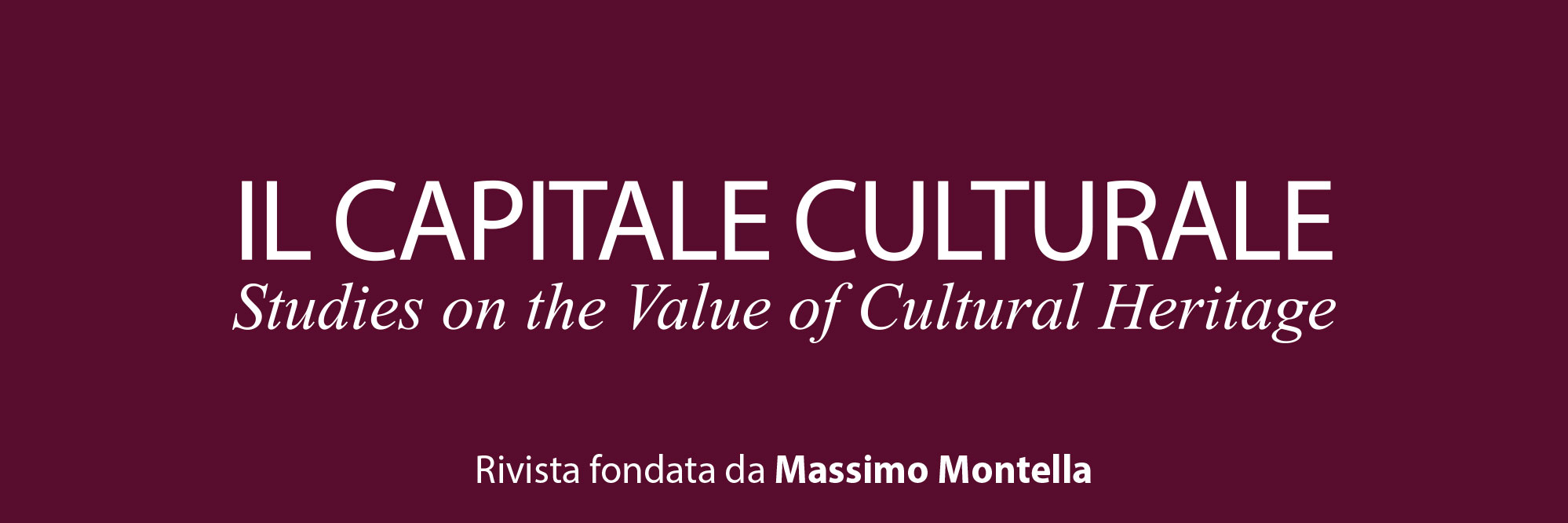The representation of Bacchic festivities in the Middle Ages: The illuminated manuscripts of the Ovide moralisé and the Ovidius moralizatus
Downloads
Pubblicato
Fascicolo
Sezione
Licenza
Tutti i materiali pubblicati sono coperti da copyright, mantenuto dall'Università di Macerata che ne supporta finanziariamente e tecnicamente la pubblicazione.
La licenza adottata è la Creative Commons - Attribuzione/Condividi allo stesso modo. Ovvero, gli autori che pubblicano su questa rivista accettano le seguenti condizioni:
- Gli autori mantengono i diritti sulla loro opera e cedono alla rivista il diritto di prima pubblicazione dell'opera, contemporaneamente licenziata sotto una Licenza Creative Commons - Attribuzione che permette ad altri di condividere l'opera indicando la paternità intellettuale e la prima pubblicazione su questa rivista.
- Gli autori possono aderire ad altri accordi di licenza non esclusiva per la distribuzione della versione dell'opera pubblicata (es. depositarla in un archivio istituzionale o pubblicarla in una monografia), a patto di indicare che la prima pubblicazione è avvenuta su questa rivista.
- Gli autori possono diffondere la loro opera online (es. in repository istituzionali o nel loro sito web) prima e durante il processo di submission, poiché può portare a scambi produttivi e aumentare le citazioni dell'opera pubblicata.
DOI:
https://doi.org/10.13138/2039-2362/3293Abstract
At the end of the third book and the beginning of the fourth book of the Metamorphoses, the particular Thebaid created by Ovid is narrated, with the entry of Bacchus into Thebes and the celebration of the Bacchic festivities. This paper aims to study the images in relation to this theme that are represented in fourteenth century illuminated manuscripts of Ovide moralisé and Ovidius moralizatus. In this analysis we will take several aspects into account: the different texts that illustrate the miniatures, the Ovide moralisé and the Ovidius moralizatus, for which the different texts will be compared; the lack of previous iconographic models of this myth, and the absence of key points in the narrative. As a consequence, each miniaturist, when converting the myth into an image, opts for a presentation of the god and his rites, with the consequent creation of different versions for this topic.
Riferimenti bibliografici
Baker, C., et al. ed. (2018), Ovide moralisé Livre I, Paris: Abbeville (Publications de la Société des anciens textes français 113).
Bijl, M. van der (1971), Petrus Berchorius. Reductorium morale Liber XV: Ovidius moralizatus, cap. ii, «Vivarium», 9, pp. 25-48.
Blume, D (2014), Visualizing Metamorphosis: Picturing the Metamorphoses of Ovid in Fourteenth Century Italy, «Troianalexandrina», 14, pp. 183-212.
Blume, D., Christel M. eds. (2021), Petrus Berchorius und der antike Mythos im 14. Jahrhundert: herausgegeben von Dieter Blume und Christel Meier, Berlin Boston: De Gruyter.
Blumenfeld-Kosinski, R. (2002), Illustrations et interprétations dans un manuscrit de l'Ovide moralisé (Arsenal 5069), «Cahiers de recherches médiévales», 9, pp. 2-13.
Bravi, G. O. et al. (1989), Codici e incunaboli miniati della Biblioteca civica di Bergamo, Bergamo, Credito bergamesco.
Camille, M. (1989) The Gothic Idol: Ideology and Image-Making in Medieval Art, London: Cambridge University Press; spanish transl. El ídolo gótico: ideología y creación de imágenes en el arte medieval, Madrid: Akal Ediciones, 2000.
Carrara, E. (1995), Bacco e Nettuno nell' "Epistre d'Othéa" di Christine de Pizan: scene di vita quotidiana e figurazioni religiose in temi mitologici, «Ricerche di Storia dell'arte», 55 pp. 83-88.
Cerrito, S. (2008), L’Ovide moralisé in prosa dal manoscritto alle edizioni a stampa: l'episodio della Scilla di Megara, «Quaderni di lingue e letterature» 33, pp. 63-78.
Cerrito, S. (2013), L'Ovide moralisé en prose entre texte et image: un livre illustré de la bibliothèque de Louis de Bruges (ms. Paris, BnF, fr. 137), in Quand l'image relit le texte, edited by H. Sandrine and S. Maud, Paris: Presses Sorbonne nouvelle, pp. 41-57.
Clier-Colombani, F. (2017), Images et Imaginaire dans l’Ovide moralisé, Paris: Honoré Champion (Essais sur le Moyen Âge 63).
Coulson, F. T., Roy, B. (2000), Incipitarium ovidianum: a finding guide for texts in Latin related to the study of Ovid in the Middle Ages and Renaissance, Turnhout, Belgium: Brepols (Publications of the Journal of medieval Latin 3).
Coulson, F.T, Haynes J. (2023), The Moralized Ovid, Cambridge, Massachusetts: Harvard University Press (Dumbarton Oaks Medieval Library, DOML 82), in press.
Croizy-Naquet, C. (2002), L'Ovide moralisé ou Ovide revisité: de métamorphose en anamorphose, «Cahiers de recherches médiévales et humanistes», 9, <https://doi.org/10.4000/crm.49>, 20.06.2023.
Degenhart, B., Schmitt, A. eds. (1980), Corpus der italienischen Zeichnungen:: 1300 - 1450. Teil 2 Bd. 3: Venedig: Addenda zu Süd- und Mittelitalien Tafel 1 – 201, Berlin: Mann.
Demats, P. (1973), Fabula: trois études de mythographie antique et médiévale, Genève:Librairie Droz.
Donzet, B., Siret, C. eds. (1981), Les Fastes du gothique: le siècle de Charles V: Galeries nationales du Grand Palais, 9 octobre 1981-1er février 1982, Paris: Ministère de la culture, Editions de la Réunion des musées nationaux.
Di Febo, M. (2017), Les enluminures des manuscrits de l’Ovide moralisé : réalisme, allégorie, merveille, in Merveilleux et marges dans le livre profane à la fin du Moyen Age (XIIe-XVe siècles), edited by A. Latimier, J. Pavlevski-Malingre, A. Servier, Turnhout: Brepols.
Dupic, J. (1950), Ovide moralisé, ms. du XIVe siècle (Bibl. de Rouen, ms. O4). Discours de réception de Mlle D. (23 mars 1946), «Précis des travaux de l’Académie des sciences, belles-lettres et arts de Rouen», pp. 1-12.
Emmerling-Skala, A. (1994), Bacchus in der Renaissance, Hildesheim, New York: G. Olms (Studien zur Kunstgeschichte, Bd. 83.).
Engels, J. (1945), Études sur l´Ovide moralisé. Groningen: J. B. Wolters.
Engels, J. (1962), Reductorium morale, liber XV, cap. ii-xv : Ovidius moralizatus : naar de Parijse druk van 1509: Metamorphosis Ovidia/na moraliter a magistro Thoma Walleys Anglico de profes/sione praedicatorum sub sanctissimo patre Dominico: explanata / venundatur in aedibus Ascesianis/ & sub pelicano in vico sancti Iacobi/ Parisiis / Petrus Berchorius. Utrecht: Instituut voor Laat Latijn der Rijksuniversiteit.
Gatti Perer, M.L., della Ragione, P. Kloster S. G. B., eds. (1995), Tesori miniati: codici e incunaboli dei fondi antichi di Bergamo e Brescia ; [Bergamo, Palazzo della Ragione, 3 marzo - 1 maggio 1995, Brescia, Monastero di S. Giulia, 18 maggio - 16 luglio 1995]. Milan, Cinisello Balsamo: Silvana.
Ghisalberti, F. (1933), L’"Ovidius moralizatus" di Pierre Bersuire, «Studi romanzi», xxiii, pp. 5-136.
Harf-Lancner, L., Pérez-Simon, M. (2015), Une lecture profane de l'Ovide moralisé: Le manuscrit BnF français 137: une mythologie illustrée, «Cahiers de recherches médiévales et humanistes», n.o 30, pp. 167-196 <https://doi.org/10.4000/crm.13888>, 20.06.2023.
Jasbar, G. (1980), Darstellungen antiker Götter im Ms. A. 10 (Augustinus, De civitate Dei) der Bibliothek der Oberschule in Schulpforte, Munich: University.
Jung, M.R. (1994), Aspects de l’Ovide moralisé, in Ovidius redivivus. Von Ovid zu Dante, edited by Picone, M., Zimmerman, B., Stuttgart: J.B. Metzler, pp. 149-72.
Jung, M.R. (1996a), Les éditions manuscrites de l’Ovide moralisé, «Cahiers d’Histoire des Littératures Romanes», 20, n.o 3-4, pp. 251-274.
Jung, M.R. (1996b), ”Ovide”, `’texte”, `’translateur” and glosses in the manuscripts of Ovide moralisé’, in Medieval Opus: Imitation, Rewriting, and Transmission in the French Tradition, edited by D. Kelly, Amsterdam: editions Rodopi B V: 75-98.
Jung, M.R. (1997), Ovide Métamorphosé en prose, Bruges, vers 1475, in A l’heure encore de mon escrire. Aspects de la littérature de Bourgogne sous Philippe le Bon et Charles le Téméraire, edited by C. Thiry, Paris: Les Lettres Romanes, pp. 99-115.
Jung, M.R. (2009), L’Ovide moralisé: de l’experience de mes lectures a quelques propositions de lecture actuelle, in Ovide Métamorphosé. Les lectures médiévaux d’Ovide, edited by L. Harf-Lancner, L. Mathey-Maille, M. Szkilnik, Paris: Presses Sorbonne nouvelle, pp. 107-22.
Kholi, O. (2012), L’iconographie d’un manuscrit de l’Ovide moralisé, Rouen O 4, Univesité de Genève.
Leclercq-Marx, J. (2009), La représentation des dieux antiques dans le premier volume des Chroniques de Hainaut (Bruxelles, KBR, ms. 9242). L'image, le texte, le contexte et la postérité, in Miscellanea in memoriam Pierre Cockshaw (1938-2008). Aspects de la vie culturelle dans les Pays-Bas bourguignons et habsbourgeois (XIVe-XVIIIe siècle), edited by F. Daelemans, A. Kelders, Brussels: Bibliothèque royale de Belgique, Brepols, pp. 243-270.
Legaré, A-M. (1990), The Master of Antoine Rolin. A Hainaut Illuminator Working in the Orbit of Simon Marmion, in Margaret of York, Simon Marmion, and the Visions of Tondal. Papers Delivered at a Symposium Organized by the Department of Manuscripts of the J. Paul Getty Museum in Collaboration with the Huntington Library and Art Collections (June 21-24, 1990), edited by T. Kren, Los Angeles: Getty Museum, pp. 209-222.
Lord, C. (1975), Three Manuscripts of the Ovide moralisé «The Art Bulletin», 57, n.o 2, pp. 161-175.
Lord, C. (1985), The Ovide moralisé and the Old Testament, in Tribute to Lotte Brand Philip, Art Historian and Detective, edited by W. W. Clarck et al., New York: Abaris Books, pp. 95-102.
Lord, C. (1995), Illustrated Manuscripts of Berchorius before the Age of Printing, in Die Rezeption der Metamorphosen des Ovid in der Neuzeit: der antike Mythos in Text und Bild ; internationales Symposion der Werner Reimers-Stiftung, Bad Homburg v.d.H. (22. bis 25. April 1991), edited by H. Walter, H. J. Horn, Berlin: G. Mann, pp. 1-11.
Lord, C. (2011), Imagery in medieval manuscripts of Ovid’s Metamorphoses and related commentaries, in Ovid in The Middle Ages, edited by J. G. Clark, F. T. Coulson, K. L. Mckinley, New York, Cambridge: Cambridge University Press, pp. 257-283.
McLaughlin, A. (2017), The Illuminated Mansucripts of Pierre Bersuire’s Ovidiius Moralizatus: A Comparative Study, University of London: The Warburg Institute.
Panfosky, E., Saxl, F. (1933), Classical Mythology in Mediaeval Art, «Metropolitan Museum Studies», 4, no 2, pp. 228-280.
Panofsky, E. (1970), Renaissance and Renascences in Western Art, Stockhholm: Almqvist & Wiksell/Gebers Förlag; spanish transl. Renacimiento y Renacimientos del Arte Occidental, Madrid: Alianza editorial, 2004.
Piqueras Yagüe, P. (2020), El Ovidius moralizatus de Pierre Bersuire. Texto, traducción y estudio, Universidad de Murcia.
Rabel, C. (1981), L’illustration de “l’Ovide moralisé” dans les manuscrits français du XIVe siècle, Essai pour une étude iconographique, Paris.
Reynolds, W. D. (1971), The Ovidius Moralizatus of Petrus Berchorius: an Introduction and Translation, Illinois: Univesity of Illinois.
Rouse, R. H., Rouse, M. A. (2000), Manuscripts and their makers: commercial book producers in medieval Paris, 1200-1500, Turnhout: H. Miller.
Ovid, Metamorphoses, translated by F. J. Miller, Cambridge, Massachusets: Loeb Classical Library, 1977-1984.
Ovid, Metamorfosis, Ed. and translated by A. Ruíz de Elvira. Madrid: Consejo superior de Investigaciones científicas, 1994.
Ovide Moralisé. Poème du commencement du quatorzième siècle, edited by C. De Boer, Amsterdam: Johannes Müller, 5 vol, 1915-1938.
Suckale-Redlefsen, G. (2011), Der Gothaer Ovid, eine Handschrift für Brunzio Visconti? Gotha, Forschungsbibliothek, Membr. I 98, «Codices Manuscripti», 32, pp. 41 – 52.
Seznec, J. (1940), La survivance des Dieux antiques, London: The Warburg Institute; spanish transl. Los dioses de la Antigüedad en la Edad Media y el Renacimiento, Madrid; Taurus, 1983.
Tesnière, M-H. (2006), Les dieux antiques dans Les Chroniques de Hainaut de Jean Wauquelin, in Jean Wauquelin. De Mons à la cour de Bourgogne, edited by M.C. de Crécy, 225-43. Turnhout: Brepols, pp. 225-243 (Burgundica, XI).
Venturini, C. (2018), Figurare dei e miti: codici miniati dell’Ovidius moralizatus, Università degli studi di Padova, PhD thesis.
Zanichelli, G. (2022), The Reception of the Ovidius moralizatus in Northern Italy in the Late Middle Ages. in After Ovid: aspects of the reception of Ovid in literature and iconography, edited by F. E. Consolino, Turnhout: Brepols, pp. 189-211 (Giornale Italiano di Filologia 28).




